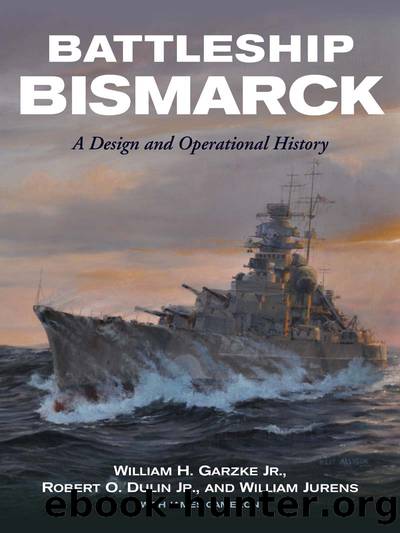Battleship Bismarck by William H. Garzke

Author:William H. Garzke
Language: eng
Format: epub
Tags: HISTORY / Military / naval
Publisher: Pen & Sword Books
Published: 2019-06-29T00:00:00+00:00
SUCCESS
Captain Brinkmann, still wanting to continue the two-ship operation and ignorant of Admiral Lütjensâs intentions, planned to send a semaphore message to Admiral Lütjens around 1800 on a proposed operation involving both ships.
â¢His fuel at 1800 was 1,350 cubic meters.
â¢Bismarck and Prinz Eugen could draw the pursuing British ships across a U-boat screen. Should contact be broken, they would head for Belchen, 1,050 miles away. If the enemy ships still maintained contact, they should continue on a southerly course and have Esso Hamburg and Spichern moved northward. Join battle if forced to by the pursuers. Otherwise, refuel with oil within one thousand miles.
â¢Ships could proceed in company directly to Belchen or Lothringen in spite of enemy contact. If enemy decides to engage, join battle.
Admiral Lütjens never received Captain Brinkmannâs proposed plan, as he decided at 1814 to make a second try to detach Prinz Eugen and sent the code word âHoodâ to begin the separation maneuver. The weather had deteriorated into a mist; Captain Brinkmann had been instructed to keep his ship on a southerly course. The gun crews on the battleship were notified to prepare for action. At 1840 Bismarck altered her heading by 180 degrees from her course of 240 degrees, made a wide turn to starboard, and then disappeared into a rain squall.
Before Bismarckâs maneuver, Suffolkâs radar had the German battleship at a distance of 25,000 meters off her port bow. Suddenly the range started to close. The radar image showed that the German battleship was at a distance of only 16,700 meters and now close on the starboard side of the British cruiser. When Bismarck emerged from a rain squall, she was a little aft of the starboard beam of Suffolk. Starting around 1842, after a brief hesitation, Bismarck fired nine salvoes in the direction of Suffolk. Captain Ellis ordered full speed and a turn of 45 degrees to port at once under a smokescreen with the flash of Bismarckâs 380-mm guns. While still under fire, the captain of Suffolk also decided to quickly alter his course to starboard and port to thwart Bismarckâs gunnery. The British cruiser began this series of violent maneuvers with salvoes from her 203-mm guns. The first salvo from Bismarck fell some distance to starboard, but the second came closer. The third salvo fell about 280 meters astern in her wake, but the explosion of their shells and the second salvo loosened some rivets in her stern structure, resulting in some minor flooding. When Suffolk returned fire with her 203-mm guns, the gun blast from turret B, firing at extreme aft train, smashed all the bridge windows, which opened the enclosed, heated bridge to cold winds and windblown spray. Gun blast also tore away the canvas covering that sheltered the bridge watch from arctic conditions. Now discomfort would be added to fatigue for those personnel on the bridge. The remainder of the salvoes from Bismarck fell harmlessly around Suffolk, as the smokescreen she was putting up foiled Bismarckâs gunnery accuracy.
Prince of Wales closed Suffolk at 1846 and began firing her 356-mm guns at Bismarck.
Download
This site does not store any files on its server. We only index and link to content provided by other sites. Please contact the content providers to delete copyright contents if any and email us, we'll remove relevant links or contents immediately.
| Africa | Americas |
| Arctic & Antarctica | Asia |
| Australia & Oceania | Europe |
| Middle East | Russia |
| United States | World |
| Ancient Civilizations | Military |
| Historical Study & Educational Resources |
The Light of Days by Judy Batalion(1064)
First Platoon: A Story of Modern War in the Age of Identity Dominance by Annie Jacobsen(904)
Stalin's War: A New History of World War II by Sean McMeekin(861)
The Pacific War 1941-1943 by James Holland(803)
Walk in My Combat Boots by James Patterson(765)
The American War in Afghanistan by Carter Malkasian(743)
Victory's Price (Star Wars) by Alexander Freed(735)
The Vietnam War: An Intimate History by Geoffrey C. Ward & Ken Burns(723)
Blood and Ruins: The Great Imperial War, 1931-1945 by Richard Overy(687)
Operation Pedestal by Max Hastings(683)
Concepts of Space by Jammer Max;(667)
Cold War (Alexander King Book 2) by Bradley Wright(661)
Extreme Fitness by Chris McNab(654)
The Madman Theory by Jim Sciutto(652)
Flying Tiger by Samson Jack(635)
World War II Infantry Fire Support Tactics by Gordon L. Rottman(612)
Pathfinders by AL-KHALILI JIM(611)
Panzerkrieg by Mike Syron(601)
Hitler’s Pre-Emptive War: The Battle for Norway, 1940 by Henrik O. Lunde(585)
